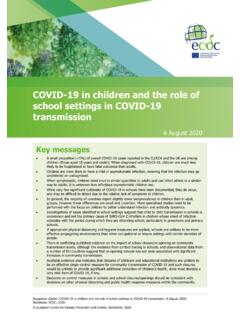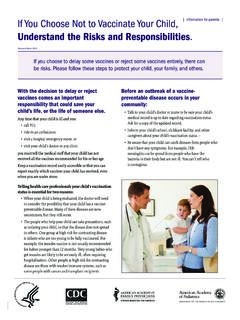Transcription of CDC Global Maternal and Child Health Care Strategy
1 Department of Health and Human ServicesCenters for Disease Control and PreventionCDC Global Maternal and Child Health Strategy 2013-2016 CDC Global Maternal and Child (MCH) Health Strategy 2013-20164 CDC Global Health Strategy 2013ffi20165 CDC Global Health Strategy 2013ffi2016 ACRONYMSANC Antenatal CareCDC Centers for Disease Control and PreventionCDC-HQ Centers for Disease Control and Prevention HeadquartersCIO Center Institute OfficeDGHA Division of Global HIV and AIDSFELTP Field Epidemiology and Laboratory Training ProgramGDD Global Disease DetectionGHI Global Health InitiativeHBB Helping Babies BreatheHHS Department of Health and Human ServicesHIV/AIDS Human Immunodeficiency Virus/Acquired Immunodeficiency SyndromeIMCI Integrated Management of Childhood IllnessM&E Monitoring and EvaluationMCH Maternal Child HealthMDG Millennium Developmental GoalMDSR Maternal Death Surveillance and ResponseMOH Ministry of HealthPEPFAR President s Emergency Plan for AIDS ReliefPMTCT Prevention
2 Of Maternal to Child Transmission of HIVSMGL Saving Mothers Giving LifeSTD Sexually Transmitted DiseasesTB TuberculosisUN United NationsUNICEF United Nations International Children s Emergency FundUS United StatesUSAID United States Agency for International DevelopmentUSG United States GovernmentVPD Vaccine-preventable diseasesVR Vital RegistrationWHO World Health OrganizationWHO-AFRO World Health Organization-Regional Office for Africa 6 CDC Global Health Strategy 2013ffi20167 CDC Global Health Strategy 2013ffi2016 EXECUTIVE SUMMARYThis CDC Global Maternal and Child Health (MCH) Strategy provides a comprehensive framework for Global MCH efforts at CDC. It promotes an integrated approach to the implementation of interventions that support MOH programs in countries and advance achievement of Global MCH goals. It emphasizes strength-ening public Health related components of the Health system that are important to achieving MCH goals.
3 The Strategy aims to ensure that CDC s technical and programmatic expertise is leveraged for maximum impact to reduce Maternal and Child morbidity and mortality. It focuses on women s Health from preconception through postpartum, and children s Health from the perinatal period through the fourth year. The Strategy builds upon existing MCH activities implemented by Centers/Institutes/Offices and by CDC s country offices in collaboration with Ministries of Health and partners. CDC has a breadth and depth of expertise in MCH from both domestic and Global MCH work that can contribute to the final big push to reach the Millennium Development Goals launched during the 2012 United Nationals General Assembly s Global MCH Strategy has two primary goals consistent with United States government and Global MCH targets: the reduction of morbidity and mortality among children under five years (under-5) and the reduction of Maternal and perinatal morbidity and mortality.
4 To support achievement of these goals and ensure sustainability, a third goal is to strengthen Health systems necessary for MCH. The fourth goal, strengthened partnerships, supports achievement of the first three goals. The objectives for each of these goals are shown in Table 1 1. CDC Global MCH Strategy Goals and ObjectivesGoalObjectives1. Reduce Under-5 Morbidity and Mortality Strengthen activities during facility-based well- Child visits to prevent morbidity and mortality among infants and children Improve care of sick infants and children Improve population and community-based disease prevention and control 2. Reduce Perinatal and Maternal Morbidity and Mortality Strengthen antenatal care to improve perinatal and Maternal outcomes Improve emergency obstetric care coverage and quality to reduce Maternal mortality and morbidity and improve perinatal outcomes Improve access to family planning and preconception Public Health Systems for MCH Strengthen surveillance and other information systems for MCH and improve use for decision-making Strengthen MCH workforce capacity Strengthen MCH-related public Health laboratory coverage and quality Improve the quality and utilization of routine Health information systems for planning and monitoring and evaluation, with a focus on the district level Improve Global MCH research at CDC Strengthen MCH capacity within National Public Health Institutes4.
5 Strengthen Partnerships Strengthen existing partnerships Identify new resources and partnership to leverage CDC s expertise8 CDC Global Health Strategy 2013ffi20169 CDC Global Health Strategy 2013ffi2016 CDC Global Maternal AND Child Health (MCH) STRATEGYI. PURPOSEThe Global MCH Strategy will guide implementation of MCH activities by CDC country offices with support from CDC Centers/Institutes/Offices (CIOs). It will also serve as a framework for discussions with CDC s partners. The anticipated timeframe for implementation of this Strategy is 2012-2016. It aligns with the CDC Global Health Vision and Mission Global Health Vision:The CDC aspires to create a world where people live healthier, safer, and longer lives. CDC Global Health Mission:CDC s Global Health mission is to protect and improve Health globally through science, policy, partnership, and evidence-based public Health action. II. BACKGROUNDCDC has a decades-long history of engaging in activities to improve MCH globally, building on its domestic expertise, and making important contributions to reducing Child mortality and morbidity around the world.
6 Most notably, CDC has been involved in a wide range of activities to prevent and control infectious diseases that affect young children. During the 1980s USAID partnered with CDC on the Combatting Childhood Communicable Diseases initiative, which addressed diarrheal diseases, VPDs, malaria, and later respiratory diseases. Following the successful eradication of smallpox in 1979, CDC has continued to make major con-tributions to Global efforts to reduce the incidence of other VPDs by supporting the Global Polio Eradication Initiative and the Global Measles and Rubella Initiative; by strengthening routine vaccination services; and by introducing and evaluating new vaccines. CDC also has a long history of working on efforts to prevent and control malaria, including supporting the President s Malaria Initiative since 2005. Since 2002, CDC has played a central role, first in the implementation of the President s Preventing Mother to Child Transmission (PMTCT) initiative (2002-2003), followed by the President s Emergency Plan for AIDS Relief (PEPFAR, since 2003), which includes PMTCT and pediatric HIV treatment and care.
7 Since 2007, CDC has partnered with WHO on the Global elimination of congenital syphilis and with WHO regional offices on the dual elimination of MTCT of HIV and syphilis. CDC staff are detailed to WHO headquarters to support reduc-ing VPDs, HIV/AIDS, and STDs, and to regional and country offices to support reducing Vaccine Prevent-able Diseases (VPDs).CDC has also contributed to Global activities related to family planning, and infant and Maternal Health . Since the 1980s CDC has provided support for nationally representative reproductive Health surveys and until the late 1990s provided technical assistance on contraceptive logistics to USAID. CDC also supports multiple other Global MCH efforts including early childhood and Maternal nutrition, Maternal and peri-natal mortality and morbidity surveillance, prevention of birth defects through food fortification with folic acid, congenital syphilis elimination, promotion of cookstoves, and prevention of unintentional injuries and violence.
8 This is the first CDC-wide Global MCH Strategy . It aligns with the United States government (USG) Global Health goals, the Department of Health and Human Services (HHS) Global Health Strategy (2011-2015), and the CDC Global Health Strategy (2012-2015), all of which support achievement of the MDGs (Table 2). The HHS Global Health Strategy has an objective to Support the USG Global Health Initiative (GHI) which emphasizes MCH. CDC s Global Health Strategy has a goal to improve the Health and well-being of people around the world, and objectives to reduce Maternal and perinatal mortality, and to reduce Child morbidity and mortality. 10 CDC Global Health Strategy 2013ffi2016 Table 2. Alignment of Global , USG, HHS, and CDC MCH-related Goals and ObjectivesGlobal MDGs USG Global Health Goals [GHI]HHS Global Health ObjectivesCDC Global Health StrategyMDG 4: Reduce Child mortalityEliminate preventable under-five mortalityReduce undernutritionSupport the GHI to achieve major improvements in Health outcomes through strengthened Health systems, with emphasis on women, children, and families, as confirmation of the US commitment to the Health -related Millennium Development Child morbidity and mortalityControl, eliminate, or eradicate vaccine-preventable diseases (VPDs)MDG 5: Reduce Maternal mortality Reduce Maternal mortalityIncrease contraceptive prevalenceReduce Maternal and perinatal mortalityMDG 6.
9 Halt spread of HIVB egin to reverse incidence of malaria and TBPrevent new HIV infectionsReduce the burden of malaria Contribute to a reduction in TB deaths and disease burden Prevent new HIV infections and serve the needs of HIV-positive individuals globallyReduce malaria morbidity and mortalityReduce TB morbidity and mortalityCDC Global Health MCH Strategy Goals and ObjectivesCDC s Global MCH Strategy is organized around achieving Global MCH goals by applying the diverse, disease specific areas of expertise at CDC to an integrated approach at the country level and to a cross-cutting approach to strengthening Health systems. The UN s Global Strategy for Women s and Children s Health has integrated delivery of Health services as one of its five key messages. Most MOHs implement MCH inter-ventions through programs that deliver integrated packages of services ( , antenatal care, well Child care, integrated management of childhood illness (IMCI) and obstetric care) and through Health systems strength-ening.
10 The Strategy seeks to take advantage of CDC expertise to provide technical assistance with identifying and applying new interventions within integrated programs or to use older interventions in innovative ways. This will require a greater level of coordination between programs at CDC-HQ and with CDC country of-fices where technical assistance to the MOH on implementation takes place. CDC s Global MCH Strategy has two primary goals consistent with USG and Global targets: the reduction of under-5 morbidity and mortality and the reduction of Maternal and perinatal morbidity and mortality. To support achievement of these primary goals and ensure sustainability, the third goal is to strengthen Health systems necessary for MCH. The fourth goal, strengthened partnerships, is critical to the achievement of the first three goals. The objectives for each of these goals are shown in Table 3. 11 CDC Global Health Strategy 2013ffi2016 Table 3. CDC Global MCH Strategy Goals and ObjectivesGoalObjectives1.















